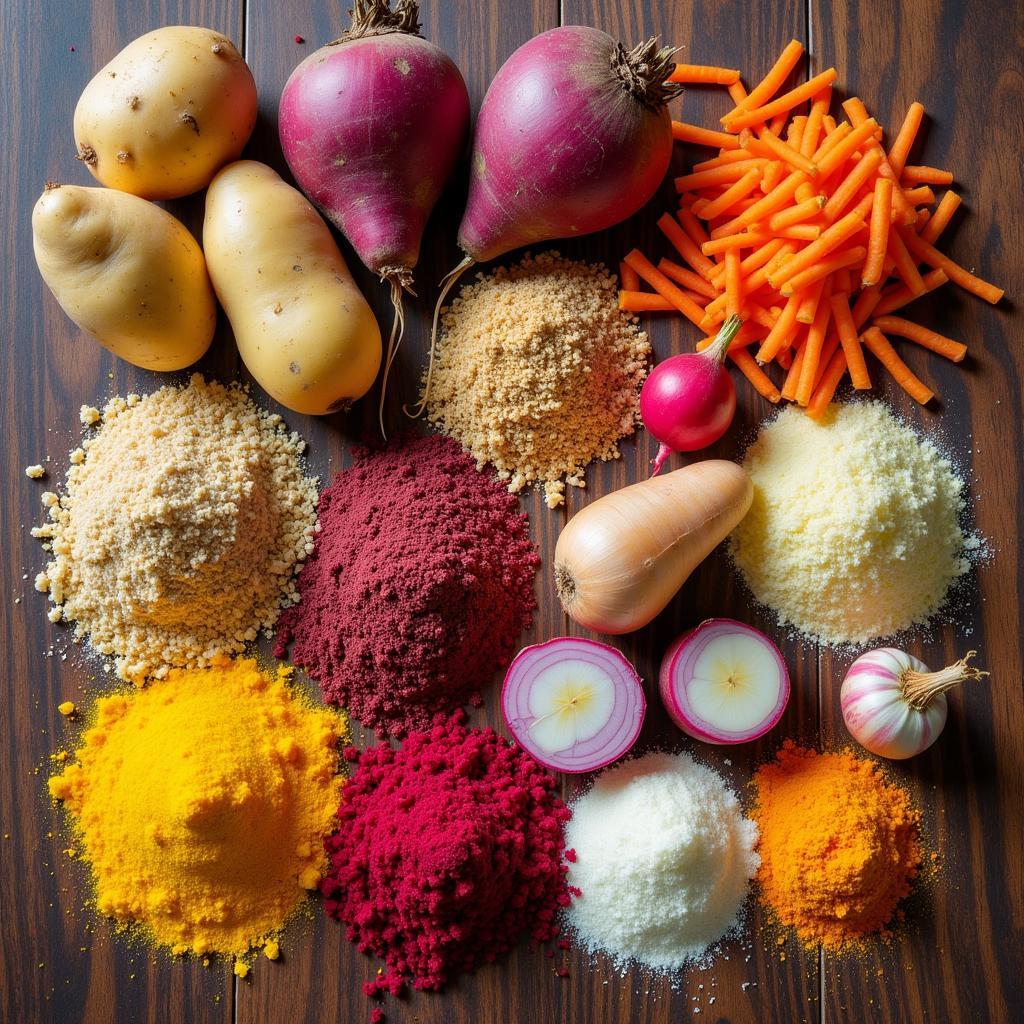Ground Food, the unsung hero of the culinary world, offers a diverse and delicious array of ingredients that can elevate your cooking to new heights. From humble roots and tubers to flavorful nuts and seeds, these earthy treasures provide a foundation for countless dishes, adding depth, texture, and nutritional value to your meals.
Whether you’re a seasoned foodie or just starting to explore the world of gastronomy, understanding the versatility and benefits of ground food can unlock a world of culinary possibilities. In this article, we’ll delve into the fascinating realm of ground food, uncovering its hidden gems and providing inspiration for your next culinary adventure.
Unearthing the Treasures: What is Ground Food?
The term “ground food” encompasses a wide range of edible plant parts that grow underground or close to the ground. This includes roots, tubers, rhizomes, bulbs, corms, and even some seeds and nuts. These nutrient-rich powerhouses have sustained civilizations for centuries, providing essential vitamins, minerals, and carbohydrates.
 Assortment of Ground Food
Assortment of Ground Food
A World of Flavor and Versatility: Exploring Different Types of Ground Food
From the familiar potato to the exotic cassava root, the world of ground food is incredibly diverse, offering a spectrum of flavors and textures to tantalize your taste buds:
-
Roots: Carrots, beets, parsnips, and radishes are just a few examples of roots that bring sweetness, earthiness, and vibrant colors to dishes.
-
Tubers: Potatoes, sweet potatoes, and yams are starchy staples known for their versatility and ability to be roasted, mashed, fried, or baked.
-
Rhizomes: Ginger, turmeric, and galangal belong to this category, prized for their distinct aromas and flavors used extensively in Asian cuisines.
-
Bulbs: Onions, garlic, and shallots are pungent flavor enhancers used in countless savory dishes worldwide.
-
Corms: Taro and water chestnuts are examples of corms, often used in Asian cuisines for their starchy texture and subtle sweetness.
 Culinary Uses of Ground Food
Culinary Uses of Ground Food
Beyond the Plate: The Nutritional Powerhouse of Ground Food
Ground food isn’t just delicious; it’s incredibly nutritious, packed with essential vitamins, minerals, and fiber:
- Fiber: Many ground foods are excellent sources of dietary fiber, promoting digestive health and regularity.
- Vitamins: Ground food is rich in vitamins like Vitamin C, B vitamins, and Vitamin A, crucial for various bodily functions.
- Minerals: Potassium, magnesium, and iron are just a few minerals found abundantly in ground food, contributing to bone health, energy production, and oxygen transport.
- Antioxidants: Some ground foods, like turmeric and ginger, are rich in antioxidants, which can help protect the body against cell damage.
“Incorporating a variety of ground food into your diet is a simple yet effective way to boost your nutrient intake and enjoy a delicious range of flavors,” says renowned nutritionist, Dr. Sarah Williams. “Their versatility makes them easy to incorporate into various dishes, ensuring you reap their nutritional benefits.”
Ground Food in the Kitchen: Tips and Tricks for Cooking
Cooking with ground food is an adventure that allows you to experiment with different flavors and textures. Here are some helpful tips to make the most of these earthy treasures:
- Storage: Store most ground food in a cool, dark, and dry place to maintain freshness.
- Preparation: Wash and scrub root vegetables thoroughly before cooking. Peeling is often optional, depending on the recipe and personal preference.
- Cooking methods: Ground food can be boiled, steamed, roasted, fried, or baked, each method yielding different textures and flavors.
- Seasoning: Don’t be afraid to experiment with different herbs, spices, and seasonings to enhance the natural flavors of ground food.
- Leftovers: Cooked ground food can be stored in the refrigerator for several days and used in salads, soups, or as a side dish.
Ground Food for Every Occasion: Recipes and Inspiration
The possibilities are endless when it comes to incorporating ground food into your meals.
-
Looking for a comforting and hearty meal? Try a ground turkey dog food recipe crockpot for your furry friend, or explore the best seeds for food plots to create a sustainable garden.
-
Need a quick and nutritious weeknight dinner? Roast a tray of root vegetables like carrots, potatoes, and sweet potatoes with herbs and spices for a simple yet satisfying meal.
-
Want to add some excitement to your breakfast routine? Blend cooked sweet potato into your oatmeal or smoothie for a creamy texture and a boost of nutrients.
 Inspiring Ground Food Recipes
Inspiring Ground Food Recipes
Ground Food: A Culinary Journey of Discovery
From ancient civilizations to modern kitchens, ground food has played a vital role in nourishing and delighting palates worldwide. Embracing the diversity and versatility of these earthy treasures opens a world of culinary possibilities, allowing you to create delicious and nutritious meals for every occasion. So, the next time you’re looking to add depth, flavor, and nutrition to your cooking, remember the humble yet mighty ground food – it might just surprise you with its incredible potential.
FAQ
1. What are some examples of ground food that are good for weight loss?
Root vegetables like turnips, radishes, and beets are low in calories and high in fiber, making them great additions to a weight loss diet.
2. Can I eat ground food raw?
While some ground food like carrots and radishes can be eaten raw, others like potatoes and yams need to be cooked to be safe for consumption.
3. How can I make ground food more appealing to picky eaters?
Roasting ground food with herbs and spices can enhance their flavor and make them more appealing. You can also try incorporating them into familiar dishes like pasta sauces, soups, and stews.
4. Are there any allergies associated with ground food?
While not as common as other food allergies, some individuals may have allergies to specific ground foods like celery root or parsley root.
5. What is the best way to store ground food long-term?
For long-term storage, consider freezing ground food after blanching. This helps preserve their flavor and texture.
Need help incorporating ground food into your diet? Contact our team at 02437655121, email us at minacones@gmail.com, or visit us at 3PGH+8R9, ĐT70A, thôn Trung, Bắc Từ Liêm, Hà Nội, Việt Nam. Our customer support team is available 24/7 to assist you. You can also find more helpful articles and recipes on our website.